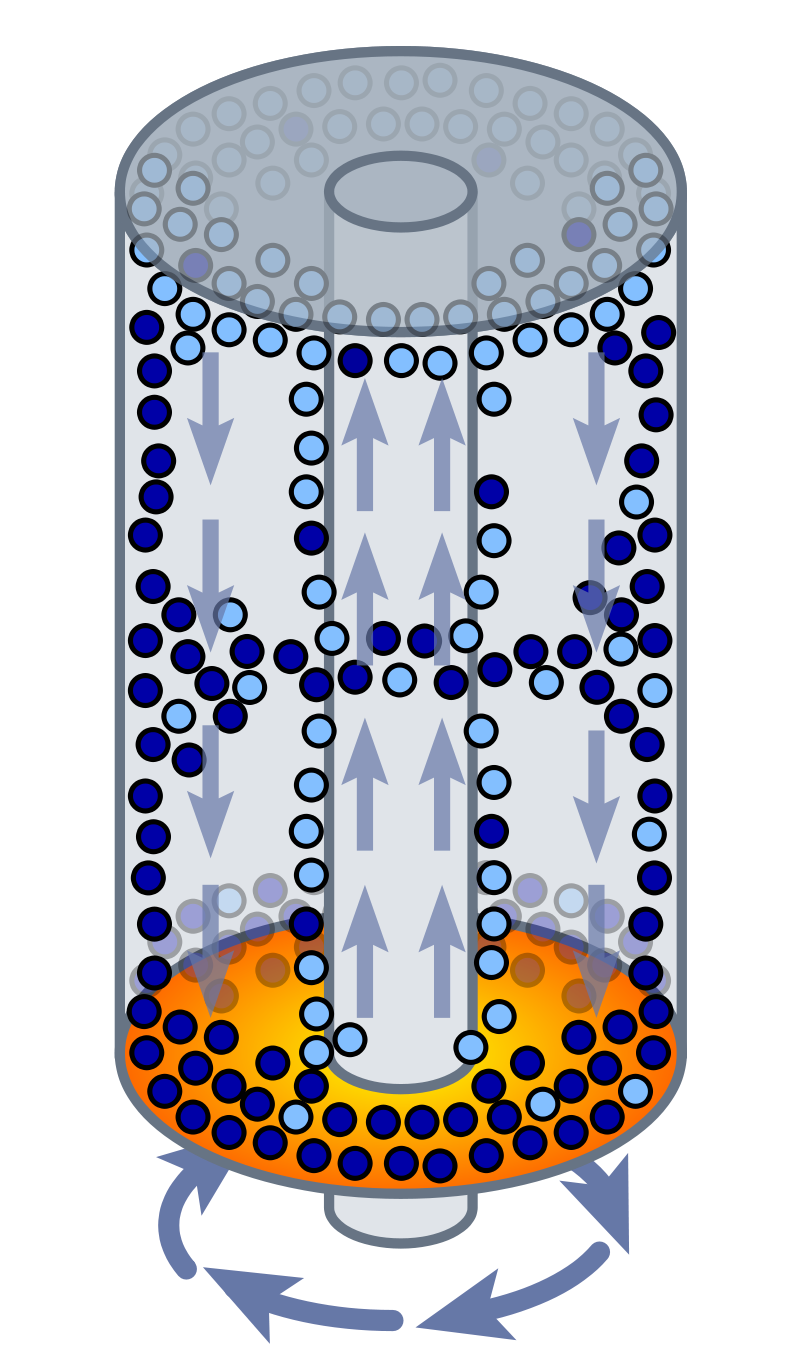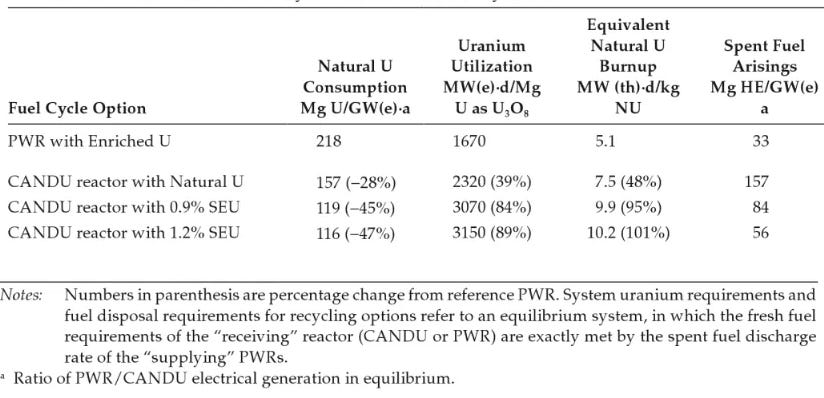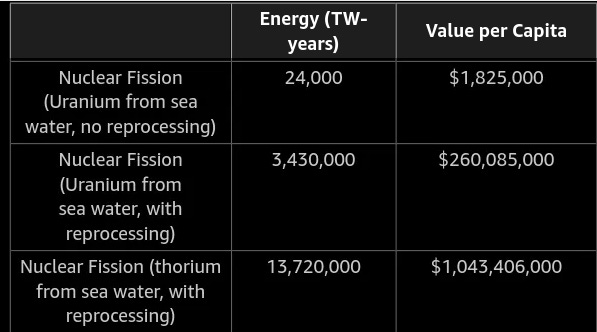Fueling The Nuclear Future
The discussion about how to tackle climate change has become more inclusive of nuclear technology in the last year.
More and more countries opt for 100% carbon-free instead of 100% renewable energy targets, as it becomes appearent that nuclear power, or firm, dispatchable, carbon-free energy in general, is a key technology for the least-cost path towards decarboniztion.
While most criticisms against nuclear power, like safety, waste and deployment speed turn out to actually be nuclear power’s strengths, the amount - and kind! - of fuel needed for a large-scale nuclear buildout pose questions.
Any nuclear reactor needs fissile material to work.
The only fissile material available in large quantities in nature is U235. But its concentration is so small that most designs will have to rely on enrichment of natural uranium or on breeding in the U/Pu or Th/U cycle to work.
Breeding decreases the need for natural uranium by over 2 orders of magnitude from 200t natural uranium per 1GWe-year to about ~1t for a breeder. This also extends how much energy humanity can derive from this resource and how much value it offers for each of the 8 billion people on earth. Thorium is roughly 4 times as abundant as uranium in the earth’s crust and would extend nuclear’s reach accordingly.
But the necessary reactors are not as mature and the materials that would have to be handled by operators are a greater proliferation concern. Especially for those who earn a living by being concerned publicly.
Enrichment
Enrichment using centrifuges is a well developed and mature technology, optimized and deployed for the existing fleet of reactors. Natural uranium with a U235 concentration of 0.7% is converted to UF6 and rapidly spinning centrifuges and a temperature differential cause the slightly lighter U235-F6 to behave sufficiently different from U238-F6 that some degree of seperation is possible. Laser enrichment is a newcomer and works by selectively exiting one of the isotopes with a laser and applying an electro-magnetic field for seperation. It could lower the costs of enrichment services further, but is frowned upon by anti-proliferation activists, who fear that clandestine programms by rogue states could be more easily concealed using this technology.
The very same technology and facilities that are used to enrich uranium for commercial reactors to about 5% U235 could be used to enrich uranium to weapons grade levels of over 80%. That is why the licensing is ardenous and the facilities are closely monitored by international institutions.1

There is probably enough “cheap”2 uranium globally to carry humanity for thousands of years. In the current political environment, enrichment has become constrained3, given that Russia accounts for ~46% of global enrichment capacity.4 Any nuclear renaissance will therefore highly likely be dependent on the build out of new enrichment capacity. The only exception to this might be CANDU-type reactors.
They are proven thermal reactors capable of using natural uranium and are therefore uneffected by any trouble regarding enrichment services. But even that design could profit from some enrichment.
Using “Slightly Enriched Uranium” (SEU) could increase the uranium utilization relative to natural uranium by 1/3 and decrease the waste mass by 2/3. Relative to PWR, a CANDU running on SEU would roughly need 1/2 as much natural uranium, but produce 2/3 more waste by weight.

The CANDU design has gained enthusiastic proponents recently, who published the Case for CANDU and emphasize the great track record of CANDU reactors around the globe, for example:
"Cernavoda-2, a CANDU-6 operating in Romania, is the top performing reactor worldwide out of 369 reactors operational between 2011 & 2021 with an average capacity factor of 94% according to the IAEA's PRIS database.” - Link
Critics are concerned that the Pu in the waste might be more usable for nefarious reasons, that the reactor could be easily converted by regimes to a weapons reactor and point to its higher mass flow of nuclear waste that needs to be recycled or stored.5
Thermal, graphite-moderated molten salt reactors can achieve far better uranium economy by using as mixture of uranium and thorium dissolved in FLiBe coolant salt enriched in Li-7, but neither the designs nor the required Li-7 are commercially available yet.6
When MSRs’ uranium is recycled, which is comparatively easy, the consumption of natural uranium could drop to 20 to 40t per GWe-year and only 24,000 SWU of enrichment.7 Additionally, the amount of Pu in the spent fuel is rather small and the isotope mixture makes it “virtually, if not literally impossible”8 to build weapons from.
Even in 2009, world uranium mining (50 kt) and enrichment capacity (57 MSWU) would have enabled over 2500 1000MWe reactors of that type.
Replacing coal boilers with molten salt reactors, proposed by various organizations9, would take an enormous bite out of the global fossil fuel usage.
Such a reactor running without Th does not have as good a neutron economy, but still an attractive uranium utilization of ~50 t/GWe-year - but only with fuel recycling that removes TRUs between batches.
U/PU Breeders
You cannot achieve net breeding with thermal reactors running on plutonium.
Therefore, you need a fast reactor to pursue this route. Fast reactors need about 5-10x the amount of fissile in the reactor core per GWe compared to thermal reactors to work. Because there is so much fissile in the core, the fear is that a bad actor could put some natural uranium in the neutron flux and cycle it out fast enough to get WGPu for multiple weapons per year, without anybody noticing.
The most mature Pu-breeders are sodium-cooled fast reactors (SFR). These are commercially developed by Terrapower10 and GEH. They boast a high-breeding factor, but have so far failed to be deployed economically. Their temperature is limited by the needed safety margin to keep sodium from boiling in some accident scenarios. Russia has a working 800 MWe sodium fast reactor and assisted China in building a 600 MWe one.
Lead-cooled fast reactors, developed by Westinghouse and Newcleo, are probably the second most mature type of Pu-breeder. They are limited in their temperature by corosion, which is a function of temperature. But at least lead is not flammable like sodium and therefore does not necessitate as costly fire-surpression systems.
Reactors cooled by supercritical light water could probably also be used as breeders. Although these reactors seem like a mere evolution of current LWRs, a lot of research will be needed to figure out corrosion issues.
Molten chloride-salt fast reactors, developed by Terrapower and Exodys are especially promising, because they allow for a breed & burn mode of operation inside the reactor, where no dedicated breeding blanket or online reprocessing beyond the removal of gaseous fission products and the removal of noble metals is needed. They could also run at higher temperatures than the metal-cooled alternatives. There is some hope that these reactors could work with natural chlorine, others believe that enriched Cl-37 will have to be used to make these reactors work as breeders. The first demonstration of a working reactor of this type has still to be done.
Once started, such a reactor would only need natural or denatured uranium as fuel, creating a huge asset from the tails of all previous enrichment activities. It would not need exotic structural materials, fuel manufacturing or recycling that produces pure Pu at any stage.
Th/U Breeders
Using Th is probably the most audacious route, because it necessitates the handling of high-enriched uranium (HEU). The breeding reactors optimized to use U233 will have to be (ideally) started with 80%+-enriched U235.
That means that it is not only necessary to have a large amount of enrichment facilities at the beginning of this nuclear pathway, but these facilities will have to produce exactly the stuff of proliferation nightmares, HEU.
Of course, the idea is to use this material in reactors for the benefit of people, and not in warheads, but the barrier of nefarious actors, state or private, would be lowered tremendously by a high availability of HEU, and the anti-proliferation mechanism installed internationally (IAEA) would become mostly void.
If we ever decided to use HEU, there are various reactor design options open, because U233 allows for breeding in the fast and thermal spectrum.
On paper, the most promising design for a practical breeding reactor using pure U233 is probably the molten salt fast flouride reactor using enriched Li-7 in the coolant salt. They seem attractive, because sufficiently simple and cheap solutions for the online fuel processing and radwaste disposal are available.11
But going the HEU route and using Th/U233, even a light-water reactor can become a breeder. In fact, it is the only proven thermal breeder to be demonstarted experimentally in the Shippingport PWR, after it had been adapted for the task. Because building a real reactor, not a paper or silicone one, is a real challenge, as Rickover’s memo so famously outlines12, the venerable PWR might be a technologically feasible route for such breeders.
U233‘s characteristics also enable innovative designs like Copenhagen Atomics’ heavy-water moderated 100 MWth reactor that fits inside a shipping container and could be mass manufactured like cars.
The way forward?
For people, whose job it is to be publicly concerned about nuclear proliferation, nuclear fuels options face these challenges:
Enrichment: LEU is grugingly accepted, but the enrichment equipment is seen as an enormous danger.
Pu: Any form of Pu is described as “weapons material”, although it is debatable, if RGPu could ever be made into one.
HEU: Just out of the question.
Therefore, unfortunately, there shouldn’t be nuclear power.
In an ideal world, with ample cheap, firm and clean energy options, and without any other risks, this might be the end of the story.
But that is not the world we live in. Continuing to firm the electricity grid with carbon-intensive fuels creates climate risks, which are often described as “extinction level”. But there is currently no low cost clean option available to developing countries focused on alleviating the very real and present risk of poverty for their citizens.
Nuclear power is not the only technology with potential uses for terrorists - and frankly, the technological and financial hurdles to build crude fizzle weapons from highly radioactive spent nuclear fuel seems exceedingly unattractive compared to biological and chemical weapons.
States, even poor ones like 1960s China, 1980s Pakistan, or 2000s North Korea, already have nuclear weapons, while various rich countries, like Japan, South Korea, Sweden, Germany or Taiwan could build nuclear weapons in a short time, but choose not to do so. It is not the technologcial limitation that is keeping these countries from devleoping such weapons, but their lack of interest in it.
Daniel Poneman proposed an IAEA initiative called the assured nuclear fuel services initiative (ANFSI) to enable depoliticized global access to enrichment and reprocessing capabilities, without sacrificing international safeguards.
Although nuclear technology is far from trivial, political or politicized questions seem far more challenging to the technology’s future.
The path of least political resistance, which doesn’t close the door for advanced designs permanently, seems to be the use of burner designs with low uranium consumption, like CANDU and thermal MSRs.
Seawater uranium extraction techniques and the fuel consumption can be improved continuously, when it becomes economically to do so.
This buys us time on the climate front and lets us postpone the question of what we want to do with RGPu to “later”.
If we failed to have economical long-term energy storage, fusion, space-based solar or more speculative alternatives economically available by “then” , which could be hundreds of years form now, even if we produced 100% of our energy consumption from such fission reactors, we would probably have done the necessary research and development for MCFRs for (relative) couch change and buy us another factor of 100x of time by burning through the RGPu and denatured uranium already stored.
If the price for a world, where carbon-free energy is abundant enough for “the other 7 billion” to make absolute poverty a thing of the past, consists of the theoretical increase in the risk of some non-state actor getting access to materials that might or might not lead to a weapon comparable to the Beirut explosion, without changing anything about that actor’s access to biological, chemical or autonomous weapons, I think it would not be the worst political trade-off we could achieve. To the contrary, it’s a debate worth having.
It has taken Centrus 8 years to get an approval to demonstrate HALEU production in the range of 20kg in 2023 with American AC100 centrifuges. Link
This is of course dependent on the uranium consumption of the designs and the cost of accessing that uranium. A lot of published research points in the direction that at $500-$5000/kg the extraction of uranium from seawater would be feasible. These prices would not pose a problem for breeders or highly efficient burners, but could hurt PWRs economically.
See for example:
A great podcast on that by Robert Bryce.
Anti-proliferation activits fear that someone could extract RGPu and theoretically build a “fizzle weapon”, a kind of low-powered nuclear weapon (~1kt yield) with hardly any military use.
ThorCon and TerrestrialEnergy are working on the designs, but will opt for cheaper, more available fuel salts and lower uranium economy, at least initially.
For example TerraPraxis or DoE. MSRs are capable of producing steam with quite similar charactersitics to coal boilers. The idea is to reuse large parts of the power plant, but to substitute the heat source.
But for presumably political reasons, they prefer HALEU as fuel source instead of Pu.
SIEMER, Darryl D. Why the molten salt fast reactor (MSFR) is the “best” Gen IV reactor. Energy Science & Engineering, 2015, 3. Jg., Nr. 2, S. 83-97. Link
The infamous memo from Rickover, regarding
“The academic-reactor designer is a dilettante. He has not had to assume any real responsibility in connection with his projects. He is free to luxuriate in elegant ideas, the practical shortcomings of which can be relegated to the category of “mere technical details.””


